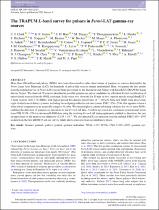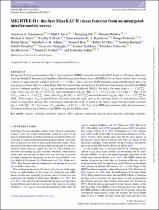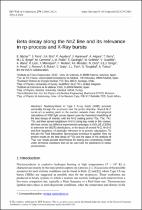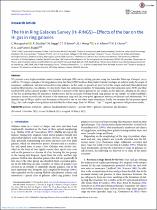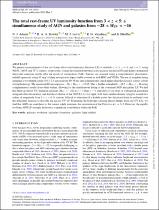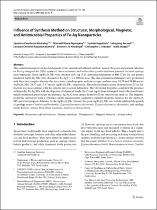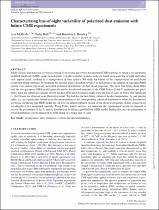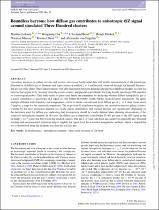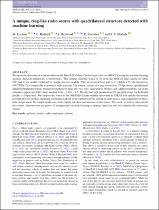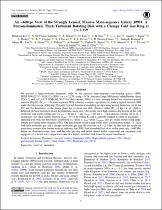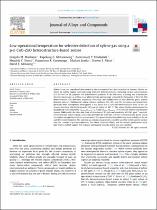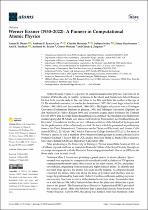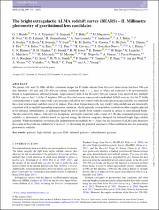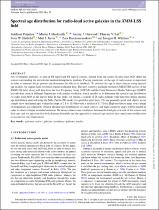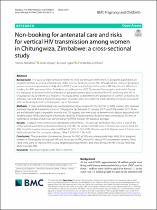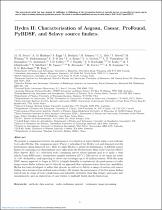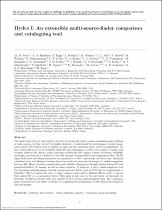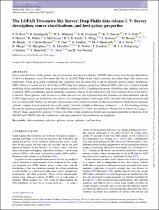Physics and Astronomy
Browse by
News
Black Holes 'NSinc: The SA discovery that’s got astronomers in a spin
A deep scan of the sky in radio waves revealed something completely unexpected to South African astronomers: that somehow, and for some unexplained reason, supermassive black holes in one region of space are all releasing radio waves in the same direction. Could this be a vital clue in understanding how the universe was formed?
Astronomers Perplexed By Rare Alignment Of Supermassive Black Holes (Youtube video)
Sub-communities within this community
Collections in this community
Recent Submissions
-
Multipole expansion for 21 cm intensity mapping power spectrum: forecasted cosmological parameters estimation for the ska observatory
(Oxford University Press, 2023)The measurement of the large-scale distribution of neutral hydrogen in the late Universe, obtained with radio telescopes through the hydrogen 21 cm line emission, has the potential to become a key cosmological probe in the ... -
The trapum l-band survey for pulsars in fermi-lat gamma-ray sources
(Oxford University Press, 2023)More than 100 millisecond pulsars (MSPs) have been discovered in radio observations of gamma-ray sources detected by the Fermi Large Area Telescope (LAT), but hundreds of pulsar-like sources remain unidentified. Here, we ... -
MIGHTEE-H I: the first MeerKAT H I mass function from an untargeted interferometric survey
(Oxford University Press, 2023)We present the first measurement of the H I mass function (HIMF) using data from MeerKAT, based on 276 direct detections from the MeerKAT International GigaHertz Tiered Extragalactic Exploration (MIGHTEE) Survey Early ... -
Beta decay along the n=z line and its relevance in rp-process and x-ray bursts
(EDP Sciences, 2023)Nucleosynthesis in Type I X-ray bursts (XRB) proceeds eventually through the rp-process near the proton drip-line. Several N=Z nuclei act as waiting points in the reaction network chain. Astrophysical calculations of XRB ... -
The h i in ring galaxies survey (h i -rings) - effects of the bar on the h i gas in ring galaxies
(Cambridge University Press, 2023)We present a new high-resolution neutral atomic hydrogen (Hi) survey of ring galaxies using the Australia Telescope Compact Array (ATCA). We target a sample of 24 ring galaxies from the Buta (1995) Southern Ring Galaxy ... -
The total rest-frame UV luminosity function from 3 < z < 5: a simultaneous study of agn and galaxies from −28 < MUV < −16
(Oxford University Press, 2023)We present measurements of the rest-frame ultraviolet luminosity function (LF) at redshifts z = 3, z = 4, and z = 5, using 96894, 38655, and 7571 sources, respectively, to map the transition between active galactic nuclei ... -
Infuence of Synthesis Method on Structural, Morphological, Magnetic, and Antimicrobial Properties of Fe‑Ag Nanoparticles
(Springer, 2023)This contribution reports on the development of two versatile and efcient methods, namely the green and gamma radiolysis for Fe-Ag nanoparticles (NPs) synthesis, characterization, and further their growth inhibition potential ... -
Characterizing line-of-sight variability of polarized dust emission with future cmb experiments
(Oxford University Press, 2023)While Galactic dust emission is often accounted for in cosmic microwave background (CMB) analyses by fitting a two-parameter modified blackbody (MBB) model in each pixel, typically a number of such clouds are found along ... -
Cosmic sands: the origin of dusty, star-forming galaxies in the epoch of reionization
(The astrophysical journal, 2023)We present the Cosmic Sands suite of cosmological zoom-in simulations based on the simba galaxy formation model in order to study the buildup of the first massive and dusty galaxies in the early universe. Residing in the ... -
Boundless baryons: how diffuse gas contributes to anisotropic tSZ signal around simulated three hundred clusters
(Oxford University Press, 2023)Upcoming advances in galaxy surveys and cosmic microwave background data will enable measurements of the anisotropic distribution of diffuse gas in filaments and superclusters at redshift z = 1 and beyond, observed through ... -
A unique, ring-like radio source with quadrilateral structure detected with machine learning
(Oxford University Press, 2023)We report the discovery of a unique object in the MeerKAT Galaxy Cluster Le gacy Survey (MGCLS) using the machine learning anomaly detection framework ASTRONOMALY. This strange, ring-like source is 30 from the MGCLS field ... -
An ∼600 pc view of the strongly lensed, massive main-sequence galaxy J0901: a baryon-dominated, thick turbulent rotating disk with a clumpy cold gas ring at z = 2.259
(The astrophysical journal, 2023)We present a high-resolution kinematic study of the massive main-sequence star-forming galaxy (SFG) SDSS J090122.37+181432.3 (J0901) at z = 2.259, using ∼0.″36 Atacama Large Millimeter/submillimeter Array CO(3-2) and ... -
Low-operational temperature for selective detection of xylene gas using a p-n CuO-ZnO heterostructure-based sensor
(Elsevier Ltd, 2023)Xylene is not just considered detrimental to the environment but also hazardous to humans. Herein we report on xylene vapour detection using CuO-ZnO heterostructures containing various concentrations (0.1–2.0 wt%) of Zn, ... -
Werner Eissner (1930–2022): a pioneer in computational atomic physics
(Atoms, 2023)Werner Eissner (Figure 1), a pioneer in computational atomic physics, was born on 16 October 1930 in the city of Görlitz, Germany, to Bernhard and Frieda (née Eckert) Eissner. He lost both parents early in life, his father ... -
The bright extragalactic ALMA redshift survey (BEARS) – II. Millimetre photometry of gravitational lens candidates
(Oxford University Press, 2023)We present 101- and 151-GHz ALMA continuum images for 85 fields selected from Herschel observations that have 500-μm flux densities >80 mJy and 250–500-μm colours consistent with z > 2, most of which are expected to be ... -
Spectral age distribution for radio-loud active galaxies in the XMM-LSS field
(Monthly Notices of the Royal Astronomical Society, 2023)Jets of energetic particles, as seen in FR type-I and FR type-II sources, ejected from the centre of radio-loud AGN affect the sources surrounding the intracluster medium/intergalactic medium. Placing constraints on the ... -
Non-booking for antenatal care and risks for vertical HIV transmission among women in Chitungwiza, Zimbabwe: a cross-sectional study
(BMC Pregnancy and Childbirth, 2022)Background: The success of prevention of mother to child transmission of HIV (PMTCT) programs dependents on pregnant women accessing antenatal care (ANC) services. Failure to access ANC throughout the course of pregnancy ... -
Hydra ii: Characterisation of Aegean, Caesar, profound, pybdsf, and selavy source finders
(Cambridge University Press, 2023)We present a comparison between the performance of a selection of source finders using a new software tool called Hydra. The companion paper, Paper I, introduced the Hydra tool and demonstrated its performance using ... -
Hydra I: An extensible multi-source-finder comparison and cataloguing tool
(Cambridge University Press, 2023)The latest generation of radio surveys are now producing sky survey images containing many millions of radio sources. In this context it is highly desirable to understand the performance of radio image source finder (SF) ... -
The lofar two-metre sky survey: Deep fields data release 1. V. Survey description, source classifications, and host galaxy properties
(Oxford University Press, 2023)Source classifications, stellar masses, and star-formation rates are presented for ≈80 000 radio sources from the first data release of the Low Frequency Array Two-metre Sky Survey (LoTSS) Deep Fields, which represents the ...

